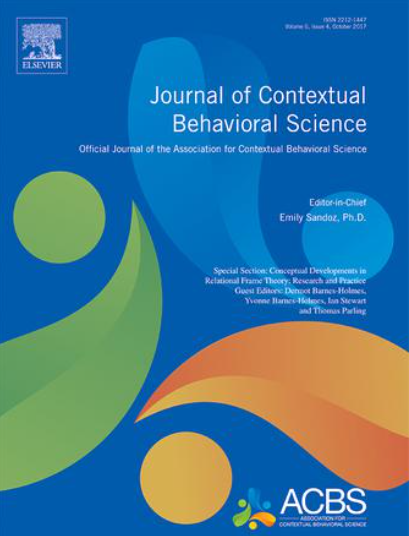A mixed methods study investigating alexithymia, experiential avoidance, and psychological distress: Insights into men with high externally oriented thinking
IF 3
3区 心理学
Q1 PSYCHOLOGY, CLINICAL
引用次数: 0
Abstract
Previous research suggests that experiential avoidance mediates the relationship between alexithymia and psychological distress. However, concerns persist regarding the validity of:
1) mediation analyses in cross-sectional samples, 2) common measures of alexithymia and experiential avoidance, and 3) solely quantitative approaches to studying alexithymic individuals. This study addresses these gaps using a sequential explanatory methodology comprising of: 1) a quantitative phase employing improved psychometric questionnaires to examine relationships between alexithymia, experiential avoidance, and distress, and 2) a qualitative phase exploring the lived experiences of individuals with alexithymia. A sample of 211 UK adults replicated prior quantitative findings, showing strong positive correlations between experiential avoidance, alexithymia, and psychological distress. However, no link was found between the Externally Oriented Thinking (EOT) facet of alexithymia and psychological distress. This led to a qualitative investigation of men with EOT, analysed using template analysis, a codebook approach to Thematic Analysis. The combined results suggest that life experiences may drive avoidance of unwanted private experiences. Moreover, the qualitative findings indicate two mechanisms explaining EOT's lack of association with psychological distress. First, EOT may serve as a protective factor against positive and negative emotional affect. Second, patriarchal norms may encourage emotional suppression and avoidant coping, leading to underreporting distress in mood questionnaires. Important theoretical and clinical implications are discussed through a Counselling Psychology lens, leading to a critique of assumptions underlying modern therapeutic techniques that may contribute to social injustice.
一项调查述情障碍、经验回避和心理困扰的混合方法研究:对具有高度外向型思维的男性的见解
先前的研究表明,体验性回避介导述情障碍和心理困扰之间的关系。然而,对以下方面的有效性的关注仍然存在:1)横截面样本的中介分析,2)述情障碍和经验回避的常用测量方法,以及3)研究述情障碍个体的单独定量方法。本研究使用顺序解释方法解决了这些空白,包括:1)定量阶段采用改进的心理测量问卷来检查述情障碍、经验回避和痛苦之间的关系,以及2)定性阶段探索述情障碍患者的生活经历。211名英国成年人的样本重复了之前的定量研究结果,表明经验回避、述情障碍和心理困扰之间存在强烈的正相关。然而,述情障碍的外向型思维(EOT)方面与心理困扰之间没有联系。这导致了对患有EOT的男性进行定性调查,使用模板分析进行分析,这是一种主题分析的代码本方法。综合结果表明,生活经历可能会促使人们回避不想要的私人经历。此外,质性研究结果指出了两种机制来解释EOT与心理困扰缺乏关联。首先,EOT可能是对积极和消极情绪影响的保护因素。其次,父权规范可能鼓励情绪压抑和回避性应对,导致情绪问卷低报痛苦。重要的理论和临床意义进行了讨论,通过咨询心理学的镜头,导致假设的现代治疗技术,可能有助于社会不公正的批评。
本文章由计算机程序翻译,如有差异,请以英文原文为准。
求助全文
约1分钟内获得全文
求助全文
来源期刊

Journal of Contextual Behavioral Science
PSYCHOLOGY, CLINICAL-
CiteScore
8.50
自引率
18.00%
发文量
82
审稿时长
61 days
期刊介绍:
The Journal of Contextual Behavioral Science is the official journal of the Association for Contextual Behavioral Science (ACBS).
Contextual Behavioral Science is a systematic and pragmatic approach to the understanding of behavior, the solution of human problems, and the promotion of human growth and development. Contextual Behavioral Science uses functional principles and theories to analyze and modify action embedded in its historical and situational context. The goal is to predict and influence behavior, with precision, scope, and depth, across all behavioral domains and all levels of analysis, so as to help create a behavioral science that is more adequate to the challenge of the human condition.
 求助内容:
求助内容: 应助结果提醒方式:
应助结果提醒方式:


